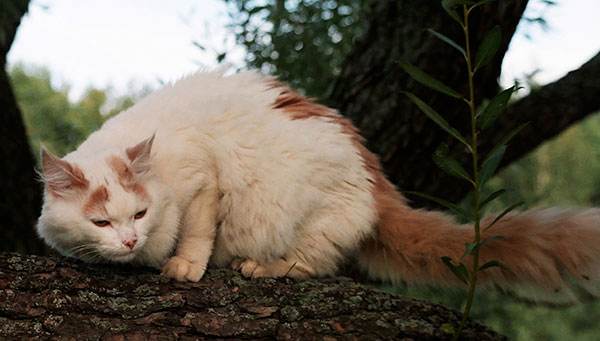Turkish Van
IUCN
LCBasic Information
Scientific classification
- name:Turkish Van
- Scientific Name:Van Kedisi,VAN CAT
- Outline:Carnivora
- Family:Felidae
Vital signs
- length:30-48cm
- Weight:3-8.5kg
- lifetime:10-18year
Feature
Türkiye's national treasure is more expensive than you can imagine
Distribution and Habitat
Native to Türkiye
Appearance
The head is medium to large. The length is at least equal to the width. The lines are rounded. There are no sharp edges, no straight lines. The cheekbones are high. The muzzle is full and rounded. There is a slight nose stop, with a delicate hook at the tip. The muzzle and cheeks are clearly separated. The chin is slightly rounded. The ears are large, wide at the base, set high, and slightly rounded at the tip. The eyes are large, chestnut or walnut shaped, and the corners of the eyes are slightly lifted. The eyelids are emphasized with pink. Color: blue, amber or different colors. Green is also acceptable, but amber is preferred. The neck is short and thick. The body is long, large and strong. The chest is rounded around the ribs. The hips are quite wide. The frame is large and muscular. The claws are moderately long. The hind legs are longer than the front legs. The bones are medium-sized and muscular. The claws are rounded. The hair between the toes is dense. The tail is moderately
Details
The Turkish Van cat is a pure natural cat that originated in the Lake Van region of Turkey. It is a mutation of the Turkish Angora cat. Strictly speaking, it is a strain of the Angora cat, so it is very similar to the Angora cat.

Turkish Van cats are particularly tenacious, have good environmental tolerance, and are very lively. Unlike ordinary cats, Turkish Van cats like to play in the water. When bathing them in warm water, they will show great interest like a baby who often bathes. Turkish Van cats are very smart and can easily get familiar with new homes and new owners. Because Van cats are masters of jumping and are lively by nature, they can appear in almost every corner of the home. They are active, playful and sleepy. They often persevere in snatching objects that interest them. Many owners call them "cat-like dogs" because their personalities are very similar to dogs.
With social changes, urbanization has caused a large number of residents to move from courtyards to apartment floors. It is becoming increasingly inconvenient for ordinary families to keep cats, and the number of van cats is decreasing. A survey in 1992 found that there were only 92 purebred cats left in the habitat of Van cats at that time. The Turkish government immediately actively carried out Van cat conservation work, not only setting up research institutions, but also breeding them in the Ankara Zoo. As the number of van cats has dropped sharply, the price has soared rapidly. At that time, the average annual income of Turks was only US$2,500, but a purebred Van cat could be sold for millions of dollars on the black market. The Turkish government has vigorously cracked down on the unscrupulous elements who smuggled and exported Van cats, but the results are not great. The van cat protection regulations that Turkey has continuously issued have increased the risks of keeping van cats. This has caused van cats to gradually withdraw from ordinary families. Since the 1990s, van cats have only appeared among members of the British royal family, and the Queen of England has a male van cat.
Currently, buying a purebred Turkish Van cat often causes great distress to all kinds of van cat lovers. In Turkey, the lowest price of a van cat was US$50,000 in the 1980s; in the 1990s, it had risen to US$300,000; around 2000, the price of a van cat rose to US$1 million; in 2011, the price of a Turkish Van cat had reached US$8 million... Moreover, because Turkish law stipulates that it cannot be taken out of the country, it has added many intangible costs to reach the hands of buyers. The excessively high price has made the Turkish Van cat farther and farther away from ordinary pet lovers.
Protect wild animals and stop eating game.
Maintaining ecological balance is everyone's responsibility!








